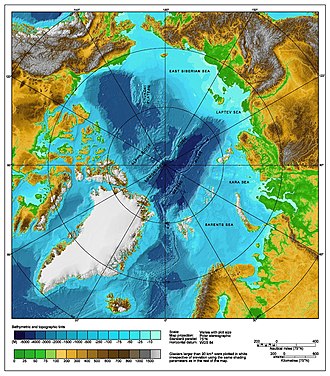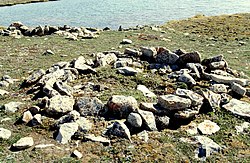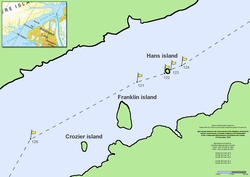Arctic Ocean
The Arctic Ocean is the ocean around the North Pole. The most northern parts of Eurasia and North America are around the Arctic Ocean. Thick pack ice and snow cover almost all of the ocean in winter and most of it in summer. An icebreaker and a nuclear-powered submarine can use the Northwest Passage through the Arctic Ocean to go between the Pacific and Atlantic Oceans.
| Earth's oceans (World Ocean) |
|---|
The Arctic Ocean has an area ocean of 14.056 million km2, the smallest of the world's five oceans, and it has a coastline of 45,389 kilometres (28,203 miles). The central surface is covered by ice about 3 metres (9.8 feet) thick.
Its biology is quite special. Endangered species include walruses, whales, and polar bears. Year by year, the Arctic Ocean is becoming less icy as a result of global warming.
The average depth of the Arctic Ocean is 1,038 metres (3,406 feet).[1] Its deepest point is in the Eurasian Basin, at 5,450 m (17,881 ft).
Geography
The Arctic Ocean covers an area of about 14,056,000 km2. The coastline is 45,390 km (28,200 mi) long[2] It is surrounded by Eurasia, North America, and Greenland and several other islands.
The ocean is generally taken to include Baffin Bay, Barents Sea, Beaufort Sea, Chukchi Sea, East Siberian Sea, Greenland Sea, Hudson Bay, Hudson Strait, Kara Sea, Laptev Sea, White Sea, and other bodies of water. It is connected to the Pacific Ocean by the Bering Strait and to the Atlantic Ocean by the Greenland Sea and the Labrador Sea.
Countries bordering the Arctic Ocean are Russia, Norway, Iceland, Greenland (part of Denmark), Canada, and the United States.
Climate
The Arctic Ocean has a polar climate. Its winter is characterized by the polar night, cold and stable weather conditions, and clear skies.
The temperature of the surface of the ocean is fairly constant, near the freezing point of seawater. The ocean consists of saltwater but has less salinity than other oceans have. The ocean's temperature must reach −1.8 °C (28.8 °F) before freezing occurs.
Ice covers almost all of the Arctic Ocean in late winter and the majority of it in late summer. Much of the Arctic ice pack is covered in snow for about 10 months of the year. The maximum snow cover is in March or April, at about 20–50 cm (7.9–19.7 in.).
The climate of the Arctic region has varied significantly in the past. As recently as 55 million years ago, during the Eocene epoch, the region reached an average annual temperature of 10–20 °C (50–68 °F). The surface waters of the Arctic Ocean warmed enough to support tropical lifeforms.
Animal and plant life
Endangered marine species in the Arctic Ocean include walruses and whales. The area has a fragile ecosystem. The Arctic Ocean has relatively little plant life except for phytoplankton. A crucial part of the ocean, phytoplankton feeds on nutrients from the rivers and currents of the Atlantic and the Pacific Oceans.
Arctic Ocean Media
The Arctic Ocean, with borders as delineated by the International Hydrographic Organization (IHO), including Hudson Bay (some of which is south of 57°N latitude, off the map) and all other marginal seas.
Emanuel Bowen's 1780s map of the Arctic features a "Northern Ocean".
The Arctic region showing the Northeast Passage, the Northern Sea Route within it, and the Northwest Passage via Canadian Inland Waters.
Distribution of the major water mass in the Arctic Ocean. The section sketches the different water masses along a vertical section from Bering Strait over the geographic North Pole to Fram Strait. As the stratification is stable, deeper water masses are denser than the layers above.
en:Nares Strait (en:Kennedy Channel) border (approx.)*Point 120–124. There is no border between point 122 and 123.*Agreement between the Government of the Kingdom of Denmark and the Government of Canada relating to the Delimitation of the Continental Shelf between Greenland and Canada. (17 December 1973)*Agreement is based on *
Changes in ice between 1990 and 1999
References
- ↑ "The Mariana Trench - Oceanography". www.marianatrench.com. 2003-04-04. Archived from the original on 2006-12-07. Retrieved 2006-12-02.
- ↑ "Arctic Ocean Fast Facts". wwf.pandora.org (World Wildlife Foundation). Archived from the original on 29 October 2010. Retrieved 2010-10-28.
Other websites
| Wikimedia Commons has media related to Lua error in Module:Commons_link at line 62: attempt to index field 'wikibase' (a nil value).. |
- The Hidden Ocean Arctic 2005 Daily logs, photos and video from exploration mission.
- Oceanography Image of the Day, from the Woods Hole Oceanographic Institution
- Arctic Council
- The Northern Forum
- Arctic Environmental Atlas Archived 2006-01-06 at the Wayback Machine Interactive map
- NOAA Arctic Theme Page
- CIA World Factbook information about Arctic Ocean
- Daily Arctic Ocean Rawinsonde Data from Soviet Drifting Ice Stations (1954–1990) Archived 2014-01-19 at the Wayback Machine at NSIDC
- Arctic time series: The Unaami Data collection Archived 2012-07-02 at the Wayback Machine
- NOAA North Pole Web Cam Images from Web Cams deployed in spring on an ice floe
- NOAA Near-realtime North Pole Weather Data Data from instruments deployed on an ice floe
- Search for Arctic Life Heats Up by Stephen Leahy
- International Polar Foundation
- National Snow and Ice Data Center – Daily report of Arctic ice cover based on satellite data
- Marine Biodiversity Wiki Archived 2011-07-23 at the Wayback Machine









